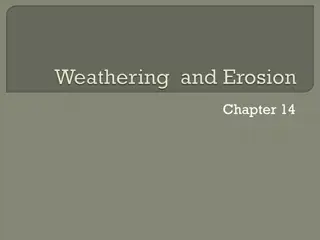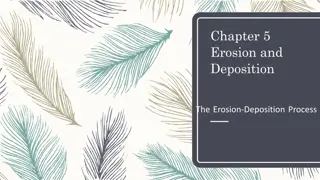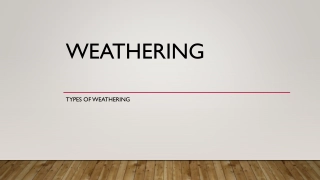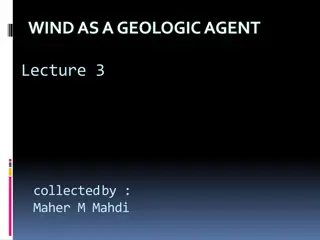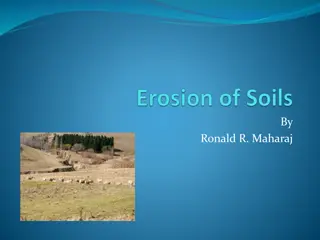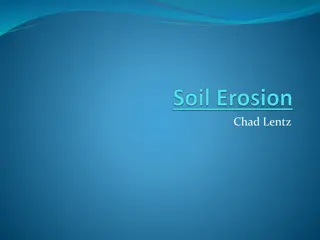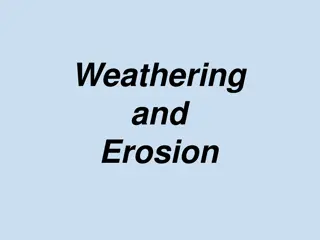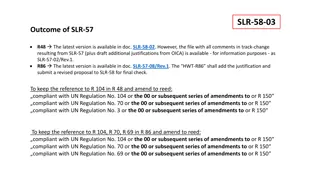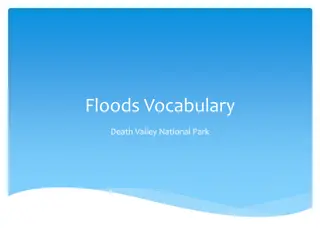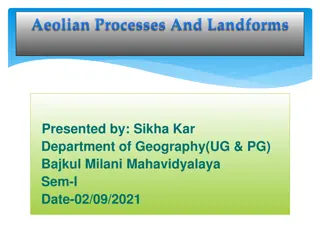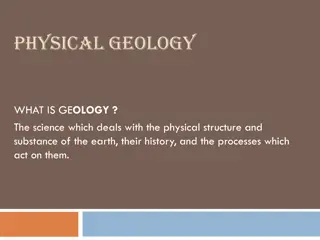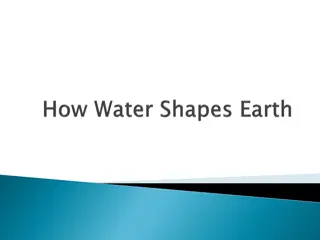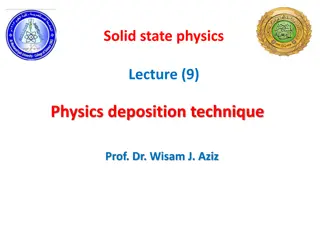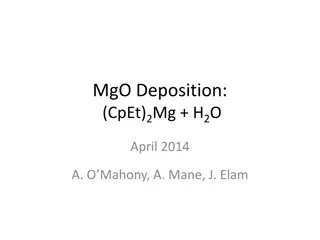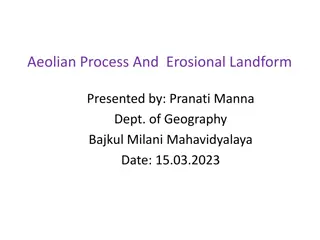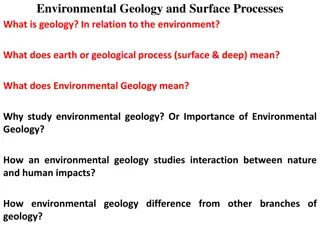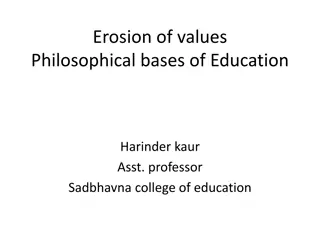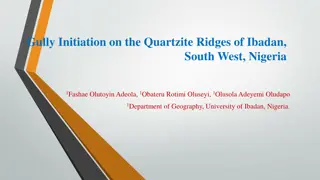Understanding Erosion, Deposition, Weathering, and Mass Movement in Geology
Explore the processes of erosion, deposition, weathering, and mass movement in geology. Learn about how rocks are broken down and carried away, the different types of weathering, and the factors affecting these processes. Discover the role of gravity in erosion and the impact of chemical reactions on rock formations.
Download Presentation

Please find below an Image/Link to download the presentation.
The content on the website is provided AS IS for your information and personal use only. It may not be sold, licensed, or shared on other websites without obtaining consent from the author. Download presentation by click this link. If you encounter any issues during the download, it is possible that the publisher has removed the file from their server.
E N D
Presentation Transcript
EROSION & DEPOSITION The creation of sedimentary rocks
WEATHERING AND MASS MOVEMENT Objectives: 1. Describe the processes by which erosion wears down and carries away rock 2. Distinguish between chemical and mechanical weathering 3. Describe the factors that affect the rate of weathering 4. Explain how the force of gravity contributes to erosion by mass movement
EROSION Definition: erosion is the process that wears down and carries away rock and soil Erosion is associated with movement from one place to another Erosion acts through weathering, the force of gravity, and through movement of streams, groundwater, glaciers, wind and waves Erosion breaks down the tallest mountains over time
WEATHERING Definition: weathering is the process by which rocks are chemically altered or physically broken down into fragments at or near Earth s surface There are 2 types of weathering: mechanical and chemical Both processes cause rocks to disintegrate and decompose Definition: mechanical weathering is the process of physically breaking rock into smaller fragments
Definition: frost wedging is physical weathering due to water seeping into cracks and expanding due to freezing Many road potholes are the result of frost wedging Definition: abrasion is physical weathering caused by the process that occurs when rocks scrape or grind against each other This can occur by water or wind
Plant roots cause physical weathering by growing into cracks breaking rocks apart Erosion causes physical weathering by removing material from the surface of the rock, releasing pressure on the rock causing the outside to crack and flake Definition: chemical weathering in a process in which rock is broken down by chemical reactions
Water is the main reactant in chemical weathering Chemical reactions dissolve the minerals that make up the rocks or changes them into new materials Water and carbon dioxide combine to form carbonic acid producing acid rain Acid rainwater dissolves many minerals Rusting, which is a kind of oxidation, occurs in minerals that are rich in iron
FACTORS THAT AFFECT THE RATE OF WEATHERING There are 3 main factors that determine how fast mechanical and physical weathering take place They are temperature, availability of water and the type of rock Certain rocks like limestone and marble undergo rapid chemical weathering since their main mineral (calcite) dissolves in water Slate, quartz and mica are more resistant to chemical change
MASS MOVEMENT Definition: mass movement is the downward movement of rock and soil due to gravity Definition: the rapid movement of large amounts of rock and soil is a landslide Landslides often happen after heavy rain Definition: mudflow is rapid mass movement of soil & other sediment with water After rain water loosens the sediment, increases its weight and causes it to flow
Definition: creep is the gradual slowing down of soil that is moving down a slope Creep usually occurs due to ice Creep happens so slowly is often hard to notice Definition: slumping occurs when weak layers of soil or rock move downslope as a single unit Gravity acting on water saturated soil and rock causes slumping
WATER SHAPES THE LAND Objectives: 1. Explain how running water erodes the land 2. Identify features formed by erosion and deposition due to running water 3. Describe how caves and sinkholes are formed by groundwater erosion
RUNNING WATER & EROSION Definition: deposition is the process in which sediment is laid down in new locations Deposition is a type of erosion Most sediment is moved by running water Running water erodes the land Definition: saltation is the process of particles bouncing along a stream bottom A large amount of deposition with a fast moving water source increases erosion Speed increases a streams ability to erode
FEATURES FORMED BY EROSION Water erosion form v-shaped valleys, waterfalls, meanders and oxbow lakes Near its source the stream moves fast, causes valley s sides to become steeper & sharply angled creating a V V-shaped valleys can contain rapids and waterfalls Waterfalls develop where a stream crosses rock layers that differ in hardness The harder layers resist erosion for the top of the waterfall while the other layers are worn away creating the cliff over which water tumbles
Definition: a flood plain is the flat area along a stream that is entirely covered only during times of flood During flooding, erosion may further widen the valley Definition: a meander is a looplike bend in the river caused by sediment being deposited on the outside of a curve in the river Features deposited by flowing water include alluvial fans and delta
Definition: an alluvial fan is sediment that has settled out as the stream flows out of the mountains creating a fan-shaped deposit Definition: a delta is mass of sediment that was carried & deposited by a stream that flows into a lake or ocean where the water slows down The delta is located where a river enters a large body of water
GROUNDWATER EROSION The processes of chemical weathering causes groundwater erosion including the formation of caves and sinkholes Acid rain moves through the ground reacting with some rocks Limestone easily erodes away forming caves and caverns Sometimes water drips into the cavern from rock layers above
Definition: a stalactite is an icicle-like formation of minerals created from water dripping from the ceiling of the cave Definition: a stalagmite is a pillar of minerals created from water dripping down to the floor Definition: a sinkhole is an entire portion of ground that has collapsed due to erosion weakening a layer of limestone Areas of southern and central US have many sinkholes



